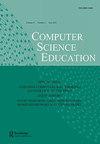Student ability and difficulties with transfer from a block-based programming language into other programming languages: a case study in Colombia
IF 2.2
Q1 EDUCATION & EDUCATIONAL RESEARCH
引用次数: 6
Abstract
ABSTRACT Background and context Transfer is a process where students apply their learning to different contexts. This process includes using their knowledge to solve problems with similar complexity, and in new contexts. In the context of programming, transfer also includes being able to understand and use different programming languages. Objective This study explores: (a) student ability to transfer from a block-based programming language into another block-based programming language; (b) student ability to transfer from a block-based programming language to a text-based programming language; (d) student ability to transfer their learning within the same programming language; and (d) the difficulties students had to transfer in these contexts. Method A group of students participating in a program called Coding For Kids explained three different programs in different programming languages during an interview protocol. The students used the programming language MakeCode, and worked on transfer activities in Scratch and Python. Findings The results suggest that while most students are able to transfer between block-based programming languages, most of them struggle to explain a program in a text-based programming language, and to solve a new coding challenge. Implications Instructional designers should consider different strategies to facilitate student transfer into professional programming languages, which is particularly difficult for non-English speakers.学生从基于块的编程语言转换为其他编程语言的能力和困难:哥伦比亚的一个案例研究
本文章由计算机程序翻译,如有差异,请以英文原文为准。
求助全文
约1分钟内获得全文
求助全文
来源期刊

Computer Science Education
EDUCATION & EDUCATIONAL RESEARCH-
CiteScore
6.90
自引率
3.70%
发文量
23
期刊介绍:
Computer Science Education publishes high-quality papers with a specific focus on teaching and learning within the computing discipline. The journal seeks novel contributions that are accessible and of interest to researchers and practitioners alike. We invite work with learners of all ages and across both classroom and out-of-classroom learning contexts.
 求助内容:
求助内容: 应助结果提醒方式:
应助结果提醒方式:


